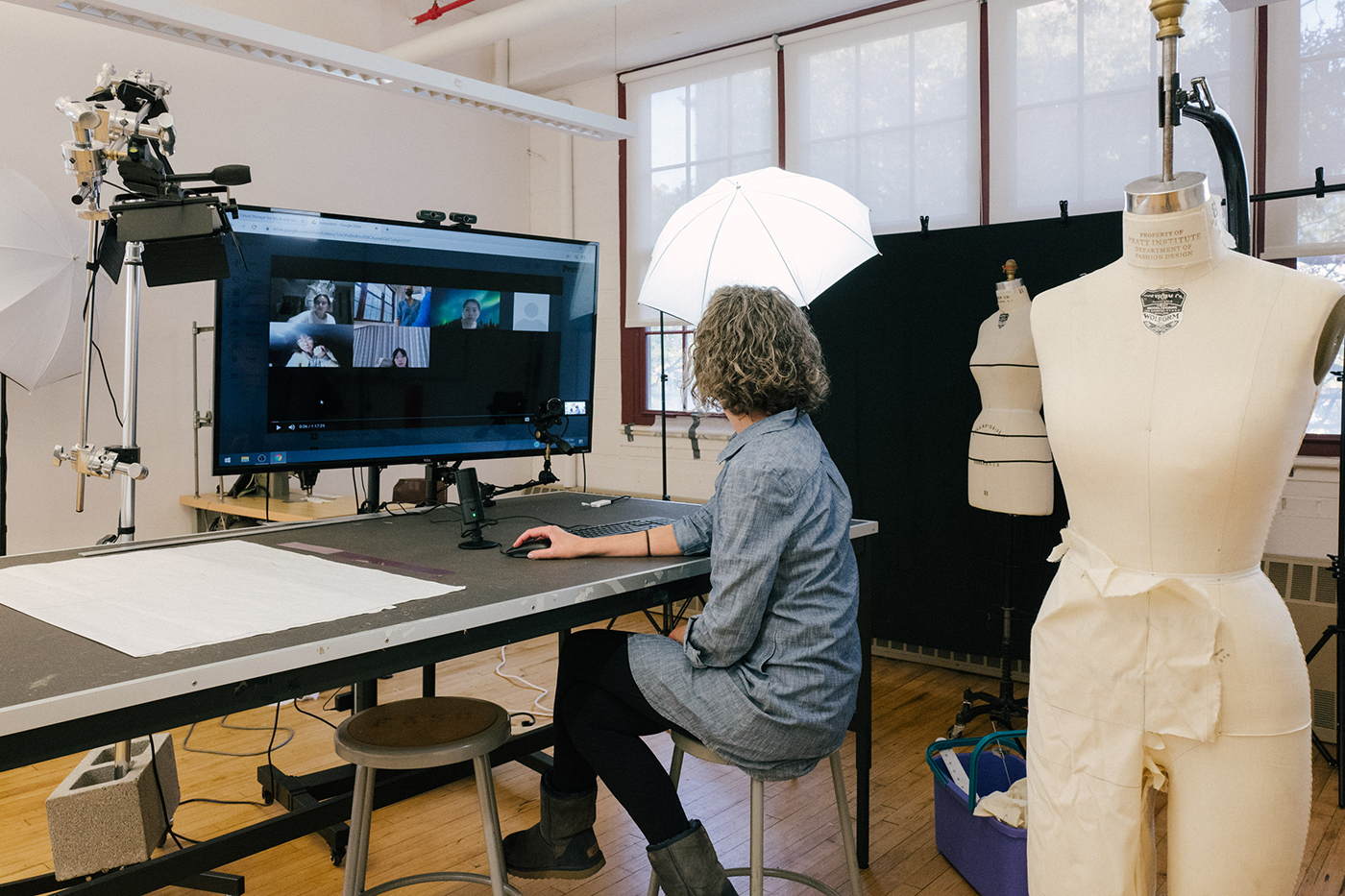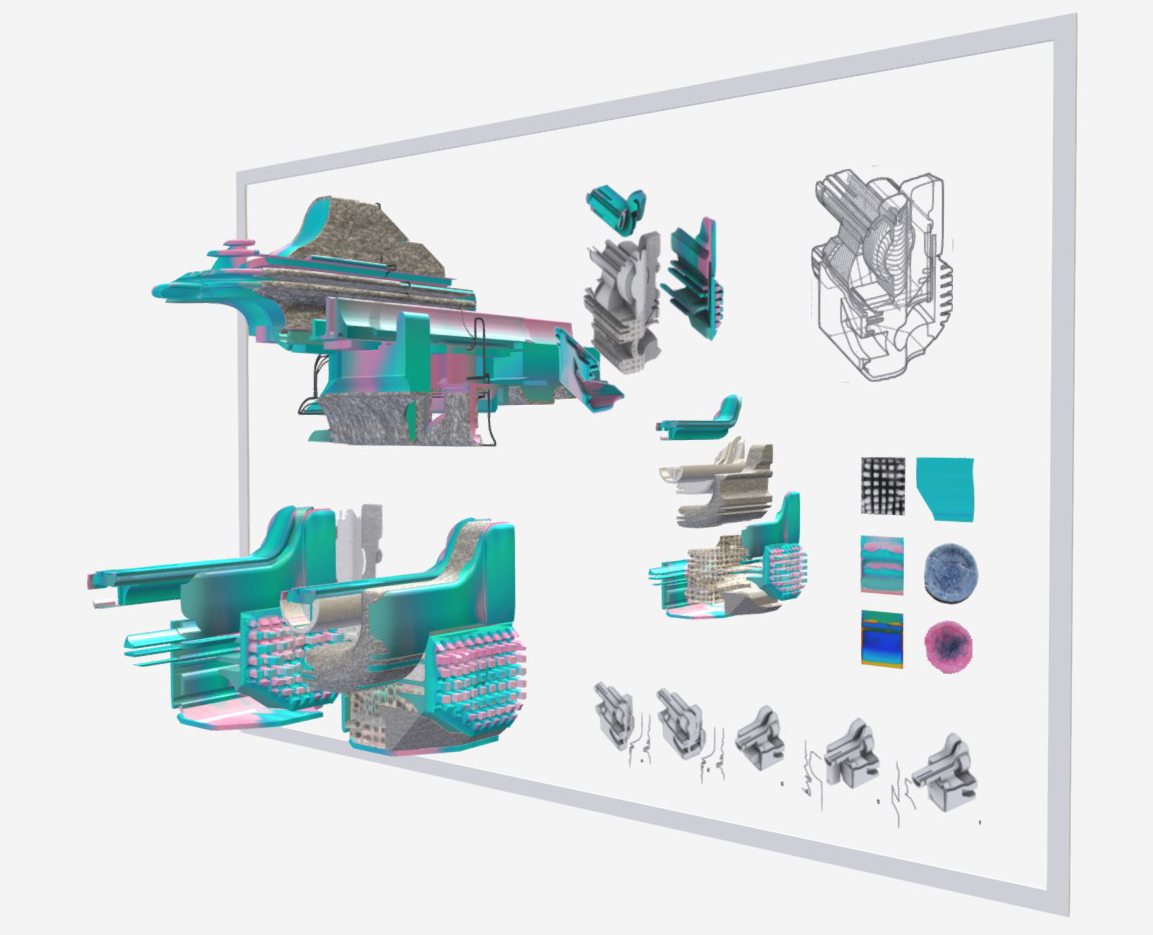The pandemic may have accelerated it, but hybrid learning has its foundation in Pratt Institute’s longstanding commitment to incorporating technology into its curriculum and making its educational experience accessible to as many students as possible.

The School of Design has reorganized its fashion studios with cameras alongside the sewing machines and dress forms so faculty members can present virtual live demonstrations to students (photo by Armon Burton)
The pandemic may have accelerated it, but hybrid learning has its foundation in Pratt Institute’s longstanding commitment to incorporating technology into its curriculum and making its educational experience accessible to as many students as possible. New modes of teaching and learning are anticipating a future where digital engagement continues to enrich the curriculum, from allowing a leading artist based in another country to virtually join a critique to enabling professors to see their students’ work concurrently on a screen. Whether on the Brooklyn or Manhattan campuses or around the world in Mumbai or Moscow, students are all part of a community that is using new platforms to collaborate, innovate, and push the boundaries of creativity across disciplines.
Katherine Huala, assistant professor of art and design education, has developed a switcher-based multi-cam setup that allows the students to see content from different sources seamlessly. The remote classroom additionally utilizes monitors to provide a clear and simultaneous picture of the students at work, including middle schoolers attending classes through the Center for Art, Design, and Community Engagement K-12 for which art and design students act as teaching assistants. The setup allows for picture-in-picture views from any of the cameras. For example, students can simultaneously observe the teacher’s hands demonstrating figure drawing as well as see the reference image. In a traditional classroom arrangement, a professor would have to leave their desk and walk around to individually see work-in-progress; Huala can respond to students one-on-one while continuing to instruct the group as a collective, breaking down the usual classroom hierarchy and increasing a sense of community.
This digital connection has further enabled faculty to bring in guest speakers and critics from around the globe and broaden opportunities for visiting instructors outside of New York. For instance, this fall the School of Architecture’s Graduate Architecture and Urban Design (GAUD) program hosted architects from around the country and abroad. Stephen Slaughter from the University of Cincinnati led a graduate design course on the Ohio River redesign of a historically disenfranchised part of the city, while Los Angeles-based architect Neil Denari, a longtime educator who created works including the curvy HL23 at the High Line, was appointed the fourth GAUD Critic at Large and is working with students and faculty throughout the academic year. Andy Bow, senior partner and deputy head of studio at Foster and Partners in London, was a regular review attendee and speaker for GAUD students this fall.
The School of Art has similarly used hybrid formats to widen participation in its Fine Arts critiques. In the past these would involve large groups meeting in a shared space; this year students set up their work in their studios so individuals could stop by for distanced visits or view it online. In previous years, people would be viewing student work on the same day as the critique, so this flexible schedule gave additional time for the art to be considered before the discussion. During the critiques, the students were in their studios while the conversation happened over Zoom, with Milanote visual boards virtually exhibiting their work.
“This can really democratize conversation,” said Chair of Fine Arts Jane South. “Frequently critiques privilege the voices of those who are confident public speakers. Hybrid critiques can include the use of a chat function, so more voices can participate and the conversations are multi-dimensional. People listen more attentively as they’re not waiting to speak, and more participants can have their voices heard. It’s also easy to share links to articles or artists mentioned in conversations so references are available instantly.”
The use of digital platforms like Milanote and Miro—where students and faculty can share projects and ideas in a free-flowing online space—has contributed to these dialogues. Architecture and design students have been using Miro digital whiteboards as virtual studios, where they not only have the space to share notes, drawings, 3D scans of physical models, videos, and other material, but also can document a whole semester of progress so they can revisit discussions and earlier work.
 Using a Miro board in a GAUD design studio with work by student Ersan ilktan in a class led by Hart Marlow, adjunct assistant professor of GAUD (courtesy Hart Marlow and GAUD)
Using a Miro board in a GAUD design studio with work by student Ersan ilktan in a class led by Hart Marlow, adjunct assistant professor of GAUD (courtesy Hart Marlow and GAUD)
“At any point, we can format the work to invite guests to view it and also leave comments which they can draw or write out as a record for the students,” said Hart Marlow, adjunct assistant professor of GAUD. “In my experience, students can lose a lot of feedback on their work when they’re trying to remember verbal comments or quickly write everything down. This allows them to better track their feedback like an interactive journal.”
These online resources have supported students from across disciplines in gathering to collaborate. In the fall semester, fine arts and writing students came together for the Third Mind Project, which involved a blog where they shared projects, ideas, poems, and essays as they explored the potential for sacred significance in everyday objects. Institutional initiatives like onePratt are also connecting students to campus labs where they can have their projects printed, milled, and cut after designing them remotely through online programs such as Launchpad which runs software through a cloud-based system.
“One thing that’s resonated in this experience is the opening up of a world of materials and fabrication for students,” said Peter Macapia, adjunct associate professor-CCE in GAUD. “Students no longer need to own their own 3D printer or access a campus lab at a certain time. OnePratt and these other online platforms open up the hard elements of production as well as connect students to the people at Pratt who are experts in what this technology can do.”
Going into the spring 2021 semester, these connections through technology will continue to expand the horizons of creativity at Pratt and prepare students to be part of a digitally-engaged community in their future practices.